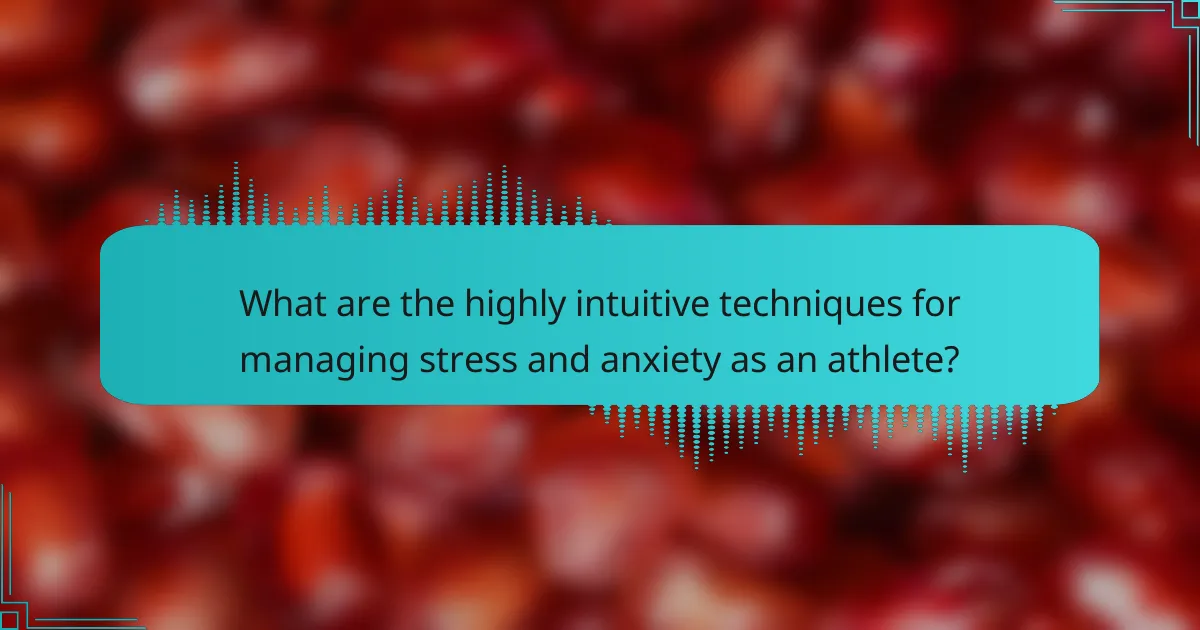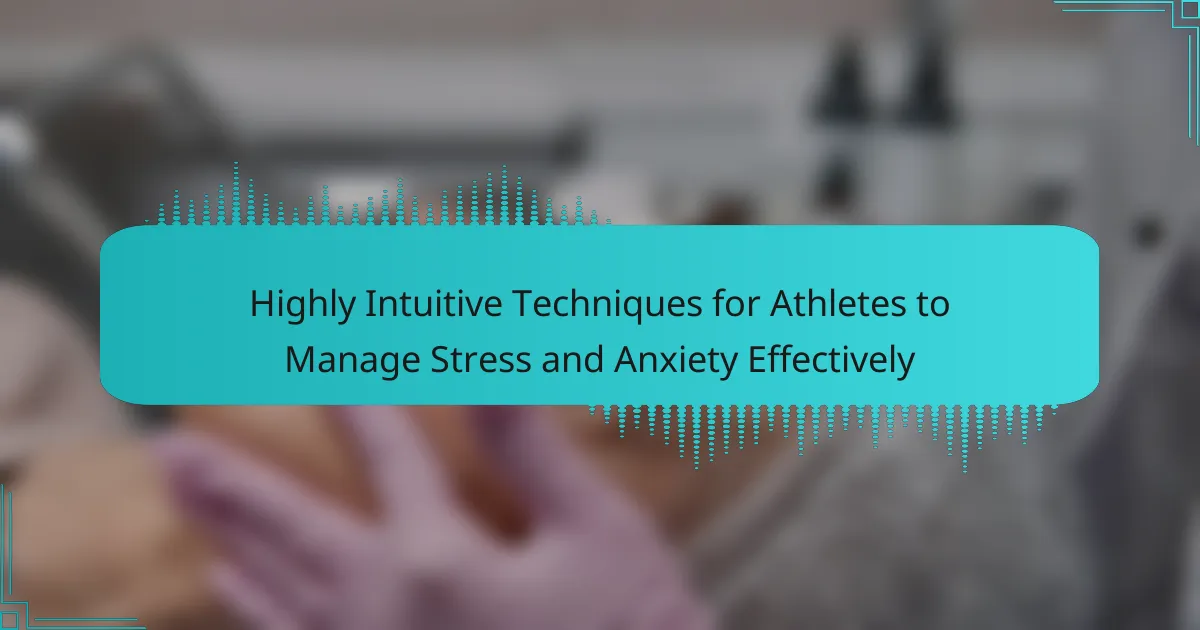Athletes often face significant stress and anxiety that can hinder performance. Effective techniques include mindfulness for present-moment awareness, visualization for confidence building, and controlled breathing to reduce physiological stress responses. These methods not only promote mental clarity but also enhance overall performance under pressure.

What are the highly intuitive techniques for managing stress and anxiety as an athlete?
Athletes can effectively manage stress and anxiety using techniques such as mindfulness, visualization, and controlled breathing. Mindfulness encourages present-moment awareness, reducing anxiety levels. Visualization helps athletes mentally rehearse performances, boosting confidence. Controlled breathing techniques, like diaphragmatic breathing, lower physiological stress responses. These methods promote mental clarity and enhance performance under pressure.
How do these techniques differ from traditional methods?
Highly intuitive techniques differ from traditional methods by focusing on personalized, holistic approaches rather than standardized practices. Traditional methods often emphasize rigid routines and external pressures, while intuitive techniques prioritize self-awareness and mental flexibility. This shift allows athletes to better understand their unique stress responses, leading to more effective management of anxiety. As a result, athletes can enhance their performance by integrating these adaptive strategies into their training.
What role does emotional awareness play in stress management?
Emotional awareness significantly enhances stress management for athletes by promoting self-regulation and resilience. Recognizing emotions allows athletes to identify stressors and respond effectively. This awareness leads to better decision-making under pressure, reducing anxiety and improving performance. Techniques such as mindfulness and reflective practices cultivate emotional awareness, fostering a proactive approach to stress. As a result, athletes can manage their emotional states, maintain focus, and optimize their training and competition experiences.
What are the steps to enhance emotional awareness?
To enhance emotional awareness, athletes can implement a series of intuitive techniques. First, practice mindfulness through meditation or deep breathing exercises to cultivate present-moment awareness. Second, engage in reflective journaling to identify and explore emotional triggers. Third, utilize visualization techniques to anticipate stressful situations and rehearse emotional responses. Fourth, seek feedback from coaches or peers to gain external perspectives on emotional behaviors. Finally, establish a supportive network for open discussions about feelings and experiences.
How can visualization techniques reduce anxiety before competitions?
Visualization techniques can significantly reduce anxiety before competitions by enhancing focus and confidence. These techniques allow athletes to mentally rehearse their performance, creating a sense of familiarity and control.
By vividly imagining successful outcomes, athletes can lower stress levels, as studies indicate that mental imagery activates the same neural pathways as actual performance. This practice fosters a positive mindset, leading to improved emotional regulation.
Additionally, visualization can serve as a unique attribute in stress management. It provides athletes with a root attribute of mental preparedness, which is crucial in high-pressure situations. As a result, athletes who regularly use visualization report feeling more relaxed and ready, ultimately enhancing their competitive performance.
What are the key elements of effective visualization?
Effective visualization for athletes managing stress and anxiety includes clarity, relevance, simplicity, and emotional engagement. These elements help convey messages powerfully and memorably.
Clarity ensures that the visual representation is easily understood, allowing athletes to quickly grasp key concepts. Relevance connects the visualization to the specific stressors athletes face, enhancing its impact. Simplicity reduces cognitive load, making it easier for athletes to focus on the information presented. Emotional engagement fosters a connection, motivating athletes to apply the techniques effectively.
Incorporating these elements can significantly improve the effectiveness of visualization techniques in stress and anxiety management for athletes.
What breathing exercises can athletes use to cope with stress?
Athletes can use techniques like diaphragmatic breathing, box breathing, and 4-7-8 breathing to manage stress effectively. These exercises promote relaxation, enhance oxygen flow, and improve focus. Diaphragmatic breathing involves inhaling deeply through the nose, expanding the diaphragm, and exhaling slowly. Box breathing consists of inhaling for four counts, holding for four counts, exhaling for four counts, and holding again for four counts. The 4-7-8 technique includes inhaling for four counts, holding for seven counts, and exhaling for eight counts. Regular practice can significantly reduce anxiety and enhance performance under pressure.
How do different breathing techniques impact performance?
Different breathing techniques significantly enhance athletic performance by reducing stress and anxiety. Techniques like diaphragmatic breathing improve oxygen flow, leading to better endurance. Box breathing helps regulate heart rate, promoting focus during competition. Controlled breathing can lower cortisol levels, aiding in recovery. Techniques that emphasize exhalation can activate the parasympathetic nervous system, fostering relaxation and mental clarity.
What is the importance of routine in managing anxiety?
Routine is crucial in managing anxiety as it provides structure and predictability. By establishing a consistent schedule, athletes can reduce uncertainty and stress levels. Engaging in familiar activities promotes a sense of control, which is vital for mental well-being. Studies show that routines can enhance focus and performance, allowing athletes to channel their energy effectively. Moreover, routines can incorporate relaxation techniques, further alleviating anxiety.
How can athletes create a personalized routine for stress relief?
Athletes can create a personalized routine for stress relief by incorporating techniques that resonate with their unique preferences and needs. Start by identifying stress triggers and preferred relaxation methods.
1. Mindfulness meditation: Practice daily for 10-15 minutes to enhance focus and reduce anxiety.
2. Physical activity: Engage in activities like yoga or jogging to release endorphins and improve mood.
3. Breathing exercises: Utilize deep breathing techniques to calm the nervous system during high-pressure situations.
4. Visualization: Imagine successful performances to build confidence and alleviate stress.
5. Scheduled downtime: Allocate specific times for rest and recovery to prevent burnout.
By tailoring these techniques to individual preferences, athletes can effectively manage stress and enhance overall performance.
What are the benefits of positive self-talk for athletes?
Positive self-talk enhances athletes’ performance by boosting confidence, reducing anxiety, and improving focus. This mental strategy fosters resilience, enabling athletes to overcome challenges and maintain motivation. Research indicates that athletes utilizing positive self-talk experience lower stress levels, leading to improved overall performance. Additionally, it cultivates a growth mindset, encouraging continuous improvement and adaptation in training and competition.
How can athletes develop a positive self-talk practice?
Athletes can develop a positive self-talk practice by implementing specific strategies. Start by identifying negative thoughts and reframing them into constructive statements. Use affirmations that resonate personally, focusing on strengths and past successes. Establish a routine for self-talk, integrating it into training sessions and competitions. Visualization techniques can enhance self-talk by creating mental scenarios where positive outcomes are achieved. Regularly practicing mindfulness can also help athletes stay present, reducing anxiety and promoting a positive mindset.
What unique strategies can elite athletes employ for stress management?
Elite athletes can employ mindfulness, visualization, and controlled breathing for effective stress management. Mindfulness enhances self-awareness, allowing athletes to focus on the present moment. Visualization techniques help in mentally rehearsing performances, reducing anxiety. Controlled breathing regulates physiological responses, promoting relaxation. These unique strategies foster resilience and improve overall performance under pressure.
How does physical activity influence mental health in athletes?
Physical activity significantly enhances mental health in athletes by reducing stress and anxiety levels. Engaging in regular exercise releases endorphins, which promote feelings of well-being. This biochemical response helps athletes cope with competitive pressures and daily stressors.
Moreover, physical activity fosters social connections through team sports, enhancing emotional support. The structured routine of training can also instill a sense of discipline and purpose, further alleviating anxiety. Research indicates that athletes who maintain consistent physical activity report lower levels of depression and anxiety compared to sedentary individuals.
Incorporating mindfulness techniques, such as yoga or meditation, into training regimens can amplify these benefits. These practices not only improve physical performance but also enhance emotional resilience, creating a holistic approach to mental health management for athletes.
What common mistakes do athletes make when managing stress?
Athletes often make several common mistakes when managing stress, which can hinder their performance. These include neglecting proper recovery, failing to communicate feelings, relying solely on physical training, and underestimating the importance of mental techniques.
Neglecting recovery can lead to burnout and increased anxiety. Failing to communicate feelings can create isolation. Relying only on physical training overlooks the mental aspect of performance. Underestimating mental techniques, like visualization and mindfulness, can limit stress management effectiveness. Recognizing and addressing these mistakes is crucial for athletes seeking to enhance their performance through effective stress management.
What are the best practices for integrating these techniques into training?
Integrating highly intuitive techniques for athletes to manage stress and anxiety effectively involves structured practices. Start by incorporating mindfulness exercises into training sessions, allowing athletes to develop awareness and control over their mental states.
Next, implement breathing techniques that can be practiced before competitions to reduce anxiety levels. Visualization strategies should also be included, enabling athletes to mentally rehearse performances and boost confidence.
Encourage regular feedback sessions where athletes can express their feelings and experiences, fostering a supportive environment. Lastly, schedule workshops focused on resilience training, equipping athletes with skills to handle pressure effectively.
How can athletes measure the effectiveness of their stress management techniques?
Athletes can measure the effectiveness of their stress management techniques through self-assessment, performance metrics, and feedback. Self-assessment involves reflecting on emotional responses during training and competition. Performance metrics, such as improved focus and reduced anxiety levels, provide quantifiable data. Feedback from coaches and peers can also highlight changes in behavior and performance, indicating successful stress management.
What expert insights can enhance an athlete’s approach to stress and anxiety?
Athletes can enhance their approach to stress and anxiety through highly intuitive techniques. Mindfulness practices, such as meditation and deep breathing, help athletes stay present and reduce anxiety. Visualization techniques allow athletes to mentally rehearse successful performances, fostering confidence. Regular physical activity releases endorphins, improving mood and resilience against stress. Establishing a strong support network provides emotional backing, crucial during high-pressure situations. Finally, maintaining a balanced routine, including adequate rest and nutrition, ensures optimal mental and physical performance.


